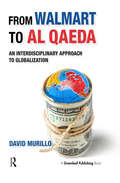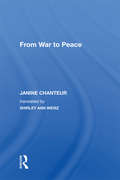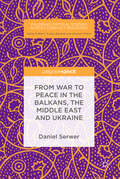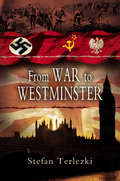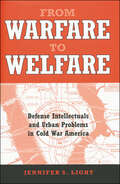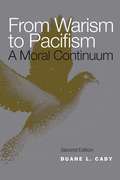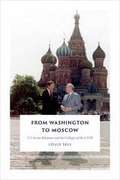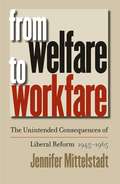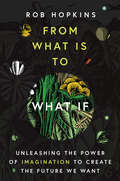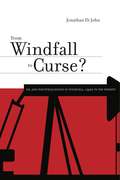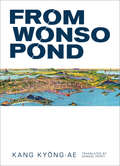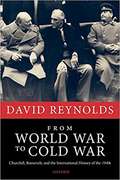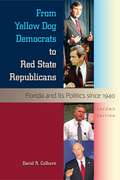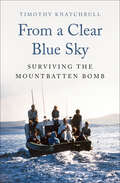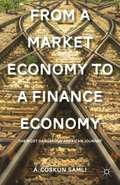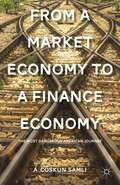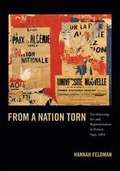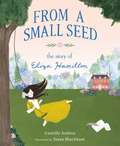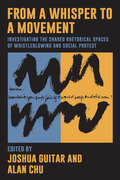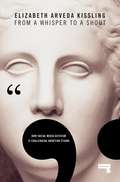- Table View
- List View
From Walmart to Al Qaeda: An Interdisciplinary Approach to Globalization
by David MurilloFrom Walmart to Al Qaeda explains the fuzzy, complex and seemingly incomprehensible concept of globalization. What is globalization? What are the core topics, theories and competing ideologies? Are we walking towards homogenization or towards a global collision of cultures and identities? The potential risks and challenges for the global economy, corporations and political regimes are acknowledged by most but not fully understood. This book provides a refreshing new look at how society is being shaped by globalization and how these apparent destructive patterns can be both explained and potentially remedied.Globalization is both a concept and a cliché. It is a term that is used to explain an economic system or the state of the world. David Murillo sets out the questions and identifies the interrelationships of different disciplines to both understand the issues and also find solutions. The book discusses globalization and current attempts to conceptualize and measure it. There are theoretical and ideological debates on whether globalization is inevitable and the various alternatives for interpreting how the world works.Accompanying Teaching Notes are available on request with the purchase of this book.
From War To Peace
by Janine ChanteurCombining political theory, gender analysis, and human psychology, this book constitutes a brilliant contribution to all these fields and is essential reading for scholars of war, peace, and human society. It argues that the hope for peace lies in rediscovering a neglected aspect of human ontology.
From War To Peace: A Guide To The Next Hundred Years
by Kent D. ShifferdThe world's first peace organizations emerged in the 19th century and since that time, anti-war activism has progressed rapidly. This illuminating book presents a realistic analysis of the extent to which the war system has infiltrated all aspects of Western culture and how it works to perpetuate war rather than promote peace. Additionally, the text describes the historically recent and still evolving parallel system of peace institutions. The values and ideas that have grown out of peace activism offer a very real opportunity to outlaw war in the coming century just as slavery was abolished in the 19th century.
From War to Peace in the Balkans, the Middle East and Ukraine (Palgrave Critical Studies in Post-Conflict Recovery)
by Daniel SerwerThis open access book focuses on the origins, consequences and aftermath of the 1995 and 1999 Western military interventions that led to the end of the most recent Balkan wars. Though challenging problems remain in Bosnia, Macedonia, Kosovo, and Serbia, the conflict prevention and state-building efforts thereafter were partly successful as countries of the region are on separate tracks towards European Union membership. This study highlights lessons that can be applied to the Middle East and Ukraine, where similar conflicts are likewise challenging sovereignty and territorial integrity. It is an accessible treatment of what makes war and how to make peace ideal for all readers interested in how violent international conflicts can be managed, informed by the experience of a practitioner.
From War to Westminster
by Stefan TerlezkiA Ukrainian-born British MP&’s memoir of being sold into slavery by Nazis as a child—and the long journey that led to his career in politics and business. Born in a small farming town in Western Ukraine that was under Polish rule at the time—but would soon be occupied and annexed by the Soviet Union and then invaded by the Germans—Stefan Terlezki was torn from his family, abducted and sold by the Nazis into slavery in Austria. Eventually, after many adventures and misadventures, he made his way to a DP camp and, finally, the UK. He would go on to be elected as a Member of Parliament for Cardiff, and become a close friend of Margaret Thatcher and other major political figures. He was also an accomplished businessman and served as chairman of his local football club, Cardiff City FC. In this book, he tells his &“remarkable&” story (BBC News). &“A moving life story.&” —Wales Online
From Warfare to Welfare: Defense Intellectuals and Urban Problems in Cold War America
by Jennifer S. LightDuring the early decades of the Cold War, large-scale investments in American defense and aerospace research and development spawned a variety of problem-solving techniques, technologies, and institutions. From systems analysis to reconnaissance satellites to think tanks, these innovations did not remain exclusive accessories of the defense establishment. Instead, they readily found civilian applications in both the private and public sector. City planning and management were no exception.Jennifer Light argues that the technologies and values of the Cold War fundamentally shaped the history of postwar urban America. From Warfare to Welfare documents how American intellectuals, city leaders, and the federal government chose to attack problems in the nation's cities by borrowing techniques and technologies first designed for military engagement with foreign enemies. Experiments in urban problem solving adapted the expertise of defense professionals to face new threats: urban chaos, blight, and social unrest. Tracing the transfer of innovations from military to city planning and management, Light reveals how a continuing source of inspiration for American city administrators lay in the nation's preparations for war.
From Warfare to Welfare: Defense Intellectuals and Urban Problems in Cold War America
by Jennifer S. LightThis study of Cold War era urban planning explores how defense technology was employed to reshape America’s cities.During the early decades of the Cold War, large-scale investments in American defense and aerospace research and development spawned a variety of problem-solving techniques, technologies, and institutions. From systems analysis to reconnaissance satellites to think tanks, these innovations soon found civilian applications in both the private and public sector. City planning and management were no exception.Jennifer Light argues that the technologies and values of the Cold War fundamentally shaped the history of postwar urban America. From Warfare to Welfare documents how American intellectuals, city leaders, and the federal government chose to attack problems in the nation’s cities by borrowing techniques and technologies first designed for military engagement with foreign enemies. Experiments in urban problem solving adapted the expertise of defense professionals to face new threats: urban chaos, blight, and social unrest. Tracing the transfer of innovations from military to city planning and management, Light reveals how a continuing source of inspiration for American city administrators lay in the nation’s preparations for war.
From Warism to Pacifism: A Moral Continuum
by Cady Duane L.Duane Cady views warism and pacifism as polar extremes on a continuum that embraces a full spectrum of ethical positions on the morality of war and peace. Realizing that he could not intellectually defend the notions of just-war theory, he found that he was a reluctant pacifist. In this new edition of From Warism to Pacifism, Cady continues to expose the pervasive, subconscious warism that is the dominant ideology in modern Western culture. He explores the changes over the last twenty years—from the end of the Cold War to the ongoing “war on terror,” as well as Barack Obama winning the Nobel Prize for Peace. Like racism and sexism, the uncritical presumption that war is morally justifiable, even morally required, misguides our attitudes and institutions. In its place, Cady proposes the development of a positive concept of peace. Citing common objections to pacifist values, he describes peace as something more than the mere absence of war and demonstrates that pacifism is a defensible position.
From Warsaw with Love: Polish Spies, the CIA, and the Forging of an Unlikely Alliance
by John PomfretFrom Warsaw with Love is the epic story of how Polish intelligence officers forged an alliance with the CIA in the twilight of the Cold War, told by the award-winning author John Pomfret.Spanning decades and continents, from the battlefields of the Balkans to secret nuclear research labs in Iran and embassy grounds in North Korea, this saga begins in 1990. As the United States cobbles together a coalition to undo Saddam Hussein’s invasion of Kuwait, six US officers are trapped in Iraq with intelligence that could ruin Operation Desert Storm if it is obtained by the brutal Iraqi dictator. Desperate, the CIA asks Poland, a longtime Cold War foe famed for its excellent spies, for help. Just months after the Polish people voted in their first democratic election since the 1930s, the young Solidarity government in Warsaw sends a veteran ex-Communist spy who’d battled the West for decades to rescue the six Americans.John Pomfret’s gripping account of the 1990 cliffhanger in Iraq is just the beginning of the tale about intelligence cooperation between Poland and the United States, cooperation that one CIA director would later describe as “one of the two foremost intelligence relationships that the United States has ever had.” Pomfret uncovers new details about the CIA’s black site program that held suspected terrorists in Poland after 9/11 as well as the role of Polish spies in the hunt for Osama bin Laden. In the tradition of the most memorable works on espionage, Pomfret’s book tells a distressing and disquieting tale of moral ambiguity in which right and wrong, black and white, are not conveniently distinguishable. As the United States teeters on the edge of a new cold war with Russia and China, Pomfret explores how these little-known events serve as a reminder of the importance of alliances in a dangerous world.
From Washington to Moscow: US-Soviet Relations and the Collapse of the USSR
by Louis SellWhen the United States and the Soviet Union signed the first Strategic Arms Limitation Talks accords in 1972 it was generally seen as the point at which the USSR achieved parity with the United States. Less than twenty years later the Soviet Union had collapsed, confounding experts who never expected it to happen during their lifetimes. In From Washington to Moscow veteran US Foreign Service officer Louis Sell traces the history of US-Soviet relations between 1972 and 1991 and explains why the Cold War came to an abrupt end. Drawing heavily on archival sources and memoirs--many in Russian--as well as his own experiences, Sell vividly describes events from the perspectives of American and Soviet participants. He attributes the USSR's fall not to one specific cause but to a combination of the Soviet system's inherent weaknesses, mistakes by Mikhail Gorbachev, and challenges by Ronald Reagan and other US leaders. He shows how the USSR's rapid and humiliating collapse and the inability of the West and Russia to find a way to cooperate respectfully and collegially helped set the foundation for Vladimir Putin's rise.
From Welfare to Workfare
by Jennifer MittelstadtIn 1996, Democratic president Bill Clinton and the Republican-controlled Congress "ended welfare as we know it" and trumpeted "workfare" as a dramatic break from the past. But, in fact, workfare was not new. Jennifer Mittelstadt locates the roots of the 1996 welfare reform many decades in the past, arguing that women, work, and welfare were intertwined concerns of the liberal welfare state beginning just after World War II.Mittelstadt examines the dramatic reform of Aid to Dependent Children (ADC) from the 1940s through the 1960s, demonstrating that in this often misunderstood period, national policy makers did not overlook issues of poverty, race, and women's role in society. Liberals' public debates and disagreements over welfare, however, caused unintended consequences, she argues, including a shift toward conservatism. Rather than leaving ADC as an income support program for needy mothers, reformers recast it as a social services program aimed at "rehabilitating" women from "dependence" on welfare to "independence," largely by encouraging them to work. Mittelstadt reconstructs the ideology, implementation, and consequences of rehabilitation, probing beneath its surface to reveal gendered and racialized assumptions about the welfare poor and broader societal concerns about poverty, race, family structure, and women's employment.
From What Is to What If: Unleashing the Power of Imagination to Create the Future We Want
by Rob Hopkins&“Big ideas that just might save the world&”—The GuardianThe founder of the international Transition Towns movement asks why true creative, positive thinking is in decline, asserts that it's more important now than ever, and suggests ways our communities can revive and reclaim it.In these times of deep division and deeper despair, if there is a consensus about anything in the world, it is that the future is going to be awful. There is an epidemic of loneliness, an epidemic of anxiety, a mental health crisis of vast proportions, especially among young people. There&’s a rise in extremist movements and governments. Catastrophic climate change. Biodiversity loss. Food insecurity. The fracturing of ecosystems and communities beyond, it seems, repair. The future—to say nothing of the present—looks grim.But as Transition movement cofounder Rob Hopkins tells us, there is plenty of evidence that things can change, and cultures can change, rapidly, dramatically, and unexpectedly—for the better. He has seen it happen around the world and in his own town of Totnes, England, where the community is becoming its own housing developer, energy company, enterprise incubator, and local food network—with cascading benefits to the community that extend far beyond the projects themselves.We do have the capability to effect dramatic change, Hopkins argues, but we&’re failing because we&’ve largely allowed our most critical tool to languish: human imagination. As defined by social reformer John Dewey, imagination is the ability to look at things as if they could be otherwise. The ability, that is, to ask What if? And if there was ever a time when we needed that ability, it is now.Imagination is central to empathy, to creating better lives, to envisioning and then enacting a positive future. Yet imagination is also demonstrably in decline at precisely the moment when we need it most. In this passionate exploration, Hopkins asks why imagination is in decline, and what we must do to revive and reclaim it. Once we do, there is no end to what we might accomplish.From What Is to What If is a call to action to reclaim and unleash our collective imagination, told through the stories of individuals and communities around the world who are doing it now, as we speak, and witnessing often rapid and dramatic change for the better.
From Windfall to Curse?: Oil and Industrialization in Venezuela, 1920 to the Present
by Jonathan Di JohnSince the discovery of abundant oil resources in the 1920s, Venezuela has had an economically privileged position among the nations of Latin America, which has led to its being treated by economic and political analysts as an exceptional case. In her well-known study of Venezuela’s political economy, The Paradox of Plenty (1997), Stanford political scientist Terry Karl argued that this oil wealth induced extraordinary corruption, rent-seeking, and centralized intervention that resulted in restricting productivity and growth. What this and other studies of Venezuela’s economy fail to explain, however, is how such conditions have accompanied both growth and stagnation at different periods of Venezuela’s history and why countries experiencing similar levels of corruption and rent-seeking produce divergent developmental outcomes. By investigating the record of economic development in Venezuela from 1920 to the present, Jonathan Di John shows that the key to explaining why the economy performed much better between 1920 and 1980 than in the post-1980 period is to understand how political strategies interacted with economic strategies—specifically, how politics determined state capacity at any given time and how the stage of development and development strategies affected the nature of political conflicts. In emphasizing the importance of an approach that looks at the political economy, not just at the economy alone, Di John advances the field methodologically while he contributes to a long-needed history of Venezuela’s economic performance in the twentieth century.
From Wonso Pond: A Korean Novel
by Kang Kyong-ae“A vibrant account of the travails of Japanese colonialism as experienced by workers and women by the pioneering feminist writer of the Korean left.” —Andre Schmid, author of Korea Between EmpiresA classic revolutionary novel of the 1930s and the first complete work written by a woman before the Korean War to be published in English, From Wonso Pond transforms the love triangle between three protagonists into a revealing portrait of the living conditions that led to modern Korea, both North and South.“A fatherless young girl now poised to become the victim of [the landlord’s] lecherous fangs and paws,” begins one of the original newspaper teasers describing From Wonso Pond and the fate of its heroine, Sonbi. In a plot rich with Dickensian overtones, the novel paints a vivid picture of life in what is now North Korea through the eyes of Sonbi, her childhood neighbor, Ch’otchae, and a restless law student, Sinch’ol, as they journey separately from a small, impoverished village ruled by the lecherous land baron to the port city of Inch’on.But life is hardly easier there, as Sonbi wears herself out boiling silk threads twelve hours a day while Ch’otchae and Sinch’ol load rice on the docks. All three become involved with underground activists, fighting the oppression of country and city, as well as their Japanese colonial rulers.“An astonishing achievement . . . From a colonized Korea, Kang sets the stage for the tragic birth of two rival nations. John Dos Passos and George Orwell may have had a Korean sister yet.” —Min Jin Lee, author of Pachinko
From Words to Worlds: Exploring Constitutional Functionality (The Johns Hopkins Series in Constitutional Thought)
by Beau BreslinIn the 225 years since the United States Constitution was first drafted, no single book has addressed the key questions of what constitutions are designed to do, how they are structured, and why they matter. In From Words to Worlds, constitutional scholar Beau Breslin corrects this glaring oversight, singling out the essential functions that a modern, written constitution must incorporate in order to serve as a nation’s fundamental law.Breslin lays out and explains the basic functions of a modern constitution—including creating a new citizenry, structuring the institutions of government, regulating conflict between layers and branches of government, and limiting the power of the sovereign. He also discusses the theoretical concepts behind the fundamentals of written constitutions and examines in depth some of the most important constitutional charters from around the world. In assaying how states put structural ideas into practice, Breslin asks probing questions about why—and if—constitutions matter.Solidly argued and engagingly written, this comparative study in constitutional thought demonstrates clearly the key components that a state’s foundational document must address. Breslin draws a critically important distinction between constitutional texts and constitutional practice.
From World War to Cold War: Churchill, Roosevelt, and the International History of the 1940s
by David ReynoldsThe 1940s was probably the most dramatic and decisive decade of the 20th century. This volume explores the Second World War and the origins of the Cold War from the vantage point of two of the great powers of that era, Britain and the USA, and of their wartime leaders, Churchill and Roosevelt. It also looks at their chequered relations with Stalin and at how the Grand Alliance crumbled into an undesired Cold War. But this is not simply a story of top-level diplomacy. <p><p> David Reynolds explores the social and cultural implications of the wartime Anglo-American alliance, particularly the impact of nearly three million GIs on British life, and reflects more generally on the importance of cultural issues in the study of international history. This book persistently challenges popular stereotypes - for instance on Churchill in 1940 or his Iron Curtain speech. It probes cliches such as 'the special relationship' and even 'the Second World War'. And it offers new views of the familiar, such as the Fall of France in 1940 or Franklin Roosevelt as 'the wheelchair president'. <p><p> Incisive and readable, written by a leading international historian, these essays encourage us to rethink our understanding of this momentous period in world history.
From Yahweh to Yahoo!: The Religious Roots of the Secular Press
by Doug UnderwoodThis wide-ranging study--hailed by American Journalism as one of the year's best books--provides a fresh and surprising view of the religious impulses at work in the typical newsroom by delving into the largely unexamined parallels between religion and journalism, from the "media" of antiquity to the electronic idolatry of the Internet. Focusing on how the history of religion in the United States has been entwined with the growth of the media, Doug Underwood argues that American journalists are rooted in the nation's moral and religious heritage and operate, in important ways, as personifications of the old religious virtues.
From Yellow Dog Democrats to Red State Republicans: Florida and Its Politics since 1940
by David R. ColburnLikely to raise hackles among Democrats and Republicans alike, this dynamic history of modern Florida argues that the Sunshine State has become the political and demographic future of the nation. David Colburn reveals how Florida gradually abandoned the traditions of race and personality that linked it to the Democratic Party. The book focuses particularly on the population growth and chaotic gubernatorial politics that altered the state from 1940, when it was a sleepy impoverished southern outpost, to the present and the emergence of a dominant Republican Party.
From a Clear Blue Sky: Surviving the Mountbatten Bomb
by Timothy KnatchbullThe prize-winning, &“exceptionally moving&” memoir of a family boat trip, an IRA bombing, and a teenager&’s loss of his twin brother (The Telegraph).Christopher Ewart-Biggs Literary Award Winner and PEN/JR Ackerley Prize Nominee On an August weekend in 1979, fourteen-year-old Timothy Knatchbull joined his family on a boat trip off the shore of Mullaghmore in County Sligo, Ireland. By noon, an Irish Republican Army bomb had destroyed the boat, leaving four dead. The author survived, but his grandparents, family friend, and twin brother did not. Lord Mountbatten, his grandfather, was the target, and became one of the IRA&’s most high-profile assassinations. Knatchbull and his parents were too badly injured to attend the funerals of those killed, which only intensified their profound sense of loss. Telling this story decades later, Knatchbull not only revisits these terrible events but also writes an intensely personal account of human triumph over tragedy—a story of recovery not just from physical wounds but deep emotional trauma.From a Clear Blue Sky takes place in Ireland at the height of the Troubles and gives compelling insight into that period of Irish history. But more importantly, it brings home that while calamity can strike at any moment, the human spirit is able to forgive, to heal, and to move on. &“A minute by minute story of what happened that day, and what happened afterwards.&” —Daily Mail &“This is an extremely moving book. Beyond providing a phenomenally detailed evocation of his own family&’s trauma, Knatchbull has lots of wise things to say about how we survive horrors—of all kinds—in our lives.&” — Zoë Heller, author of the Booker Prize finalist Notes on a Scandal &“A very poignant, clearsighted, heartbreaking but ultimately positive account.&” —Hugh Bonneville, The New York Times
From a Market Economy to a Finance Economy
by A. Coskun SamliIn this gripping book, Dr. Samli makes the case that the US economy is shifting for the worse, tilting towards a finance-driven economy, and argues that investing in innovation will bring us out of the recession and back to a successful, market-driven economy.
From a Market Economy to a Finance Economy: The Most Dangerous American Journey
by A. SamliIn this gripping book, Dr. Samli makes the case that the US economy is shifting for the worse, tilting towards a finance-driven economy, and argues that investing in innovation will bring us out of the recession and back to a successful, market-driven economy.
From a Nation Torn: Decolonizing Art and Representation in France, 1945-1962
by Hannah FeldmanFrom a Nation Torn provides a powerful critique of art history's understanding of French modernism and the historical circumstances that shaped its production and reception. Within art history, the aesthetic practices and theories that emerged in France from the late 1940s into the 1960s are demarcated as postwar. Yet it was during these very decades that France fought a protracted series of wars to maintain its far-flung colonial empire. Given that French modernism was created during, rather than after, war, Hannah Feldman argues that its interpretation must incorporate the tumultuous "decades of decolonization"and their profound influence on visual and public culture. Focusing on the Algerian War of Independence (1954-1962) and the historical continuities it presented with the experience of the Second World War, Feldman highlights decolonization's formative effects on art and related theories of representation, both political and aesthetic. Ultimately, From a Nation Torn constitutes a profound exploration of how certain populations and events are rendered invisible and their omission naturalized within histories of modernity.
From a Small Seed - The Story of Eliza Hamilton
by Camille AndrosA lyrical picture book biography of Eliza Schuyler Hamilton, co-founder and director of the first private orphanage in New York City and wife of founding father Alexander Hamilton.Ever since she was a young girl, Eliza Hamilton hoped to help people in need. From the private quarters of her family home to her national platform as Hamilton’s partner, Eliza was a lifelong advocate for fairness, freedom and faith. The remarkable acts of charity and public service she performed after Alexander’s death are considered a significant contribution to the Hamilton legacy the world celebrates today. Here is a thoughtful, historical account of her life beginning with her childhood influences.Much like the award-winning picture book biographies that celebrate trailblazing women like The House that Jane Built: A Story About Jane Addams and Hillary Rodham Clinton: Some Girls Are Born to Lead, Camille Andros and Tessa Blackham's From a Small Seed—The Story of Eliza Hamilton is an accessible portrait of an exemplary public figure whose principles have stood the test of time. Christy Ottaviano Books
From a Whisper to a Movement: Investigating the Shared Rhetorical Spaces of Whistleblowing and Social Protest (SUNY series, Studies in Human Rights)
by Joshua Guitar Alan ChuThrough substantive case studies on issues of human rights, this collection of rhetorical investigations engages the interactions among whistleblowers, public protest, and relationships of power.While whistleblowers are commonly viewed as disempowered members of institutions who expose acts of wrongdoing, From a Whisper to a Movement argues that whistleblowing acts can occur from an assemblage of persons and places not typically associated with the term. This theoretical foundation affords us the ability to substantively interrogate the rhetorical linkage between solitary whistleblowing acts, scaffolded around a sense of democratic ethics, and the rhetoric of the consequent publics that demand corrective action. As mass social protests often emerge from singular moments of discovery, the connected discourses expose a unique site within the public forum rich with rhetorical significance. While not all whistleblowing utterances prompt public protests, and only some protests coalesce around the disclosure of wrongdoing, recent history demonstrates that exposed abuses of power often prompt collective action in the name of human rights. This volume interrogates how disempowered actors, often working alone, can inform democratic discourse and global movements.
From a Whisper to a Shout: How Social Media Activism Is Challenging Abortion Stigma
by Elizabeth KisslingAbortion remains legal in the US, but access has been slowly eroded since prohibition was ruled unconstitutional nearly fifty years ago. Simultaneously abortion remains culturally stigmatised – it is kept secret and presumed shameful. But feminist activists are working to increase access and challenge this stigma. Numerous organisations and campaigns are challenging abortion stigma using the internet and social media and intersectional feminist sensibilities. From A Whisper to a Shout takes a closer look at four of these organisations – #ShoutYourAbortion, Lady Parts Justice, #WeTestify, and The Abortion Diary – and how they are integrating feminist tactics, social media, and political strategies to challenge abortion stigma and promote abortion access.
